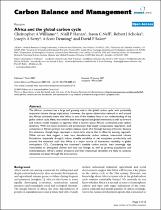JavaScript is disabled for your browser. Some features of this site may not work without it.
- ResearchSpace
- →
- Research Publications/Outputs
- →
- Journal Articles
- →
- View Item
| dc.contributor.author |
Williams, CA

|
|
| dc.contributor.author |
Hanan, NP

|
|
| dc.contributor.author |
Neff, JC

|
|
| dc.contributor.author |
Scholes, RJ

|
|
| dc.contributor.author |
Berry, JA

|
|
| dc.contributor.author |
Denning, AS

|
|
| dc.contributor.author |
Baker, DF

|
|
| dc.date.accessioned | 2007-06-28T14:25:43Z | |
| dc.date.available | 2007-06-28T14:25:43Z | |
| dc.date.issued | 2007-03 | |
| dc.identifier.citation | Williams, CA et al. 2007. Africa and the global carbon cycle. Carbon balance and management, Vol. 2(3), pp 1-13 | en |
| dc.identifier.issn | 1750-0680 | |
| dc.identifier.uri | http://hdl.handle.net/10204/710 | |
| dc.description | Copyright: 2007 BioMed Central Ltd | en |
| dc.description.abstract | The African continent has a large and growing role in the global carbon cycle, with potentially important climate change implications. However, the sparse observation network in and around the African continent means that Africa is one of the weakest links in our understanding of the global carbon cycle. Here, data from regional and global inventories as well as forward and inverse model analyses to appraise what is known about Africa's continental-scale carbon dynamics has been combined. With low fossil emissions and productivity that largely compensates respiration, land conversion is Africa's primary net carbon release, much of it through burning of forests. Savanna fire emissions, though large, represent a short-term source that is offset by ensuing regrowth. While current data suggest a near zero decadal-scale carbon balance, inter annual climate fluctuations (especially drought) induce sizeable variability in net ecosystem productivity and savanna fire emissions such that Africa is a major source of inter annual variability in global atmospheric CO2. Considering the continent's sizeable carbon stocks, its seemingly high vulnerability to anticipated climate and land use change, as well as growing populations and industrialization, Africa's carbon emissions and its inter annual variability are likely to undergo substantial increases through the 21st century | en |
| dc.language.iso | en | en |
| dc.publisher | BioMed Central Ltd | en |
| dc.subject | Global carbon cycle | en |
| dc.subject | Savanna fire emissions | en |
| dc.subject | Atmospheric emissions | en |
| dc.subject | African continent | en |
| dc.title | Africa and the global carbon cycle | en |
| dc.type | Article | en |
| dc.identifier.apacitation | Williams, C., Hanan, N., Neff, J., Scholes, R., Berry, J., Denning, A., & Baker, D. (2007). Africa and the global carbon cycle. http://hdl.handle.net/10204/710 | en_ZA |
| dc.identifier.chicagocitation | Williams, CA, NP Hanan, JC Neff, RJ Scholes, JA Berry, AS Denning, and DF Baker "Africa and the global carbon cycle." (2007) http://hdl.handle.net/10204/710 | en_ZA |
| dc.identifier.vancouvercitation | Williams C, Hanan N, Neff J, Scholes R, Berry J, Denning A, et al. Africa and the global carbon cycle. 2007; http://hdl.handle.net/10204/710. | en_ZA |
| dc.identifier.ris | TY - Article AU - Williams, CA AU - Hanan, NP AU - Neff, JC AU - Scholes, RJ AU - Berry, JA AU - Denning, AS AU - Baker, DF AB - The African continent has a large and growing role in the global carbon cycle, with potentially important climate change implications. However, the sparse observation network in and around the African continent means that Africa is one of the weakest links in our understanding of the global carbon cycle. Here, data from regional and global inventories as well as forward and inverse model analyses to appraise what is known about Africa's continental-scale carbon dynamics has been combined. With low fossil emissions and productivity that largely compensates respiration, land conversion is Africa's primary net carbon release, much of it through burning of forests. Savanna fire emissions, though large, represent a short-term source that is offset by ensuing regrowth. While current data suggest a near zero decadal-scale carbon balance, inter annual climate fluctuations (especially drought) induce sizeable variability in net ecosystem productivity and savanna fire emissions such that Africa is a major source of inter annual variability in global atmospheric CO2. Considering the continent's sizeable carbon stocks, its seemingly high vulnerability to anticipated climate and land use change, as well as growing populations and industrialization, Africa's carbon emissions and its inter annual variability are likely to undergo substantial increases through the 21st century DA - 2007-03 DB - ResearchSpace DP - CSIR KW - Global carbon cycle KW - Savanna fire emissions KW - Atmospheric emissions KW - African continent LK - https://researchspace.csir.co.za PY - 2007 SM - 1750-0680 T1 - Africa and the global carbon cycle TI - Africa and the global carbon cycle UR - http://hdl.handle.net/10204/710 ER - | en_ZA |






